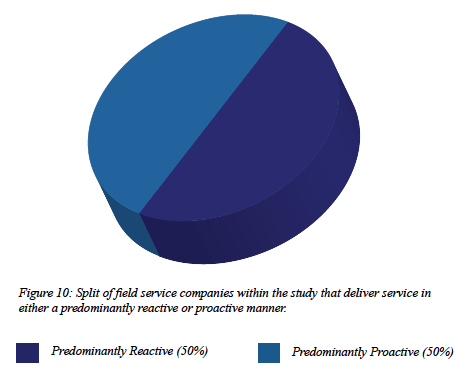How different is the future?
Within this series of features, we have already seen several key trends emerge from the data revealed from the field service companies within our response group…
The data has shown how we have reached a point where much of the industry has a reasonable maturity in terms of technology adoption related to field service operations:
- We have seen the importance of customer service within the top-line growth strategies of field service companies.
- We have seen how the focus on digital transformation is aimed at driving improvements in customer service standards.
- We have seen how the pandemic has significantly accelerated that digital transformation.
These findings would suggest that the field service sector is ready to drive forward in the other key trend we have seen develop across the last decade within our industry – a shift from traditional reactive break-fix approach to service delivery through to a more sophisticated servitized approach.
In the final part of our study, we focused on understanding whether we are beginning to see that shift occur. To begin, we wanted to understand how far we have come along the reactive to proactive spectrum as an industry.

We asked our respondents to identify on a sliding scale whether their service was predominantly reactive or proactive. The results of this question showed an industry very much in a moment of flux as the response across all respondents was 50/50 split between the two, (figure 10, right)
However, in our next question in this section, we saw a further indication of the shift towards advanced services. We asked our respondents if they offered any advanced services (i.e. servitization or outcome-based services) within their service portfolio. Here we saw that nearly two-thirds (58%) of field service companies did have some form of advanced service offering within their service portfolio.
One observation here that this data could support is that an advanced services offering does not necessarily mean abandoning your existing service models.
As we have seen across this study, the importance of understanding customer needs and wants is increasingly at the heart of modern field service strategies.
Indeed, as we delved further into how those companies with a servitized offering approached introducing this into their service portfolio, this observation was further borne out. While 51% of the field service companies within the study had introduced such an offering as part of an internal offering, 49% of companies had done so either in partnership and co-creation with their customers or their customers’ direct requests.
Finally, the other shift that aligns with this rapidly changing dynamic within the field service sector is the changing workforce models. The use of third-party workforces is becoming increasingly widespread. When correctly used, the blended workforce (a mix of internal and third-party field workers) has benefits closely aligned with the dual benefits of increasing customer satisfaction, while reducing cost within field service operations also shown to be being driven by digital transformation.
Within this area, we asked our respondents to identify the mix on average between internal and third-party workers within their field workforce. Across the entire response set, the average blend of field workforce was 36% third party. Additionally, almost all external workers (87%) were from subcontractor firms. However, there are the seeds of the use of the gig economy being employed within field service roles as 12% of companies that use third party labour also hire from this pool.
Study Conclusions: Four Key Takeaways and a Glimpse of the New Normal?
It seems clear from the study’s findings that our industry is currently experiencing some significant changes in multiple areas.
- We see the shift from the first wave of field service management systems that now form the backbone of field service operations to a newer breed of service solutions when it comes to technology. As we outlined earlier in the report, this is a shift best defined as the difference between digitalisation and digital transformation.
- This new wave of technology is very much aligned with an increased focus on placing customer satisfaction and customer success at the heart of our operations within the field service sector and at the heart of our growth strategies. As a result, the field service sector has genuinely become a truly customer-centric industry.
- This fact also lies at the heart of the increasing move towards servitization, which has been driven as much by our industry’s customers as it has by the field service organisations themselves.
- Much of this transformation that we see across the industry has been advancing for a while. Still, there is no denying that the pandemic has had a significant impact on accelerating our progress on the journey that we had already begun.
There has been much talk of building the new normal in the field service sector.
This study has revealed a glimpse of what the central pillars of that new normal will be.
An increase in sophistication in our service strategy and design, an embrace of the technology that we have now firmly put our faith in to empower us in our endeavours and finally, customer success lying at the heart of everything we do.

This content is available exclusively for FSN Premium members. Please either log-in or subscribe for access


